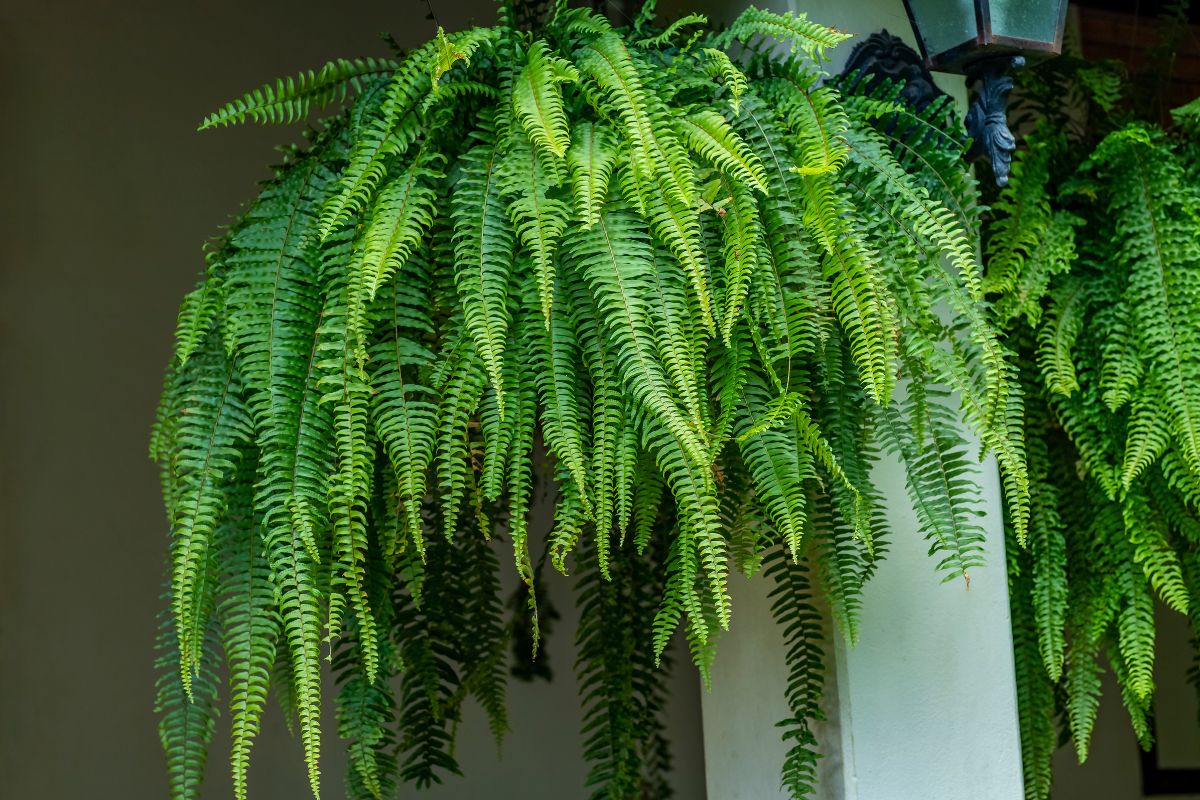Are Ferns Perennials?
Ferns (Pteridophyta) are perennial plants that have existed since the prehistoric era, making them some of the planet’s oldest living organisms. But do ferns come back every year?
Once established, they persist for a very long time, and unlike other plant species, they reproduce using spores rather than seeds or pollen. Ferns have adapted to other plants’ struggles because they can grow in various conditions.

Do Ferns Come Back Every Year?
Ferns will wither away in the winter when it becomes cold, but they will start to grow again in the spring. For the winter, you leave fern plants alone in the ground. The middle crown of the plant, where new growth will appear in the spring, will enjoy shielding from the fronds. Ferns are resilient perennial plants that reappear every year.
Many gardeners bring potted ferns indoors over the winter to continue growing. In the spring, evergreen and deciduous ferns grow new leaves. New fiddleheads, or crosiers, will develop in the middle of the plant in the spring and early summer if you remove old deciduous fern fronds in the late autumn and all the old evergreen fronds at the end of the winter.
Can Ferns Survive Winter?
Hardy ferns can withstand outside winter conditions, yet many can withstand intense heat. Hardy ferns are a great option for year-round outdoor pots in most areas because of this. The U.S. Department of Agriculture’s plant hardiness zone 3 is suitable for the coldest-tolerant ferns. Many flourish in the temperate rain forests of Alaska, Canada, and the Pacific Northwest.
However, your type of fern and where you live significantly impact whether your potted fern can survive outdoors in freezing weather. Hardy ferns are a great option for year-round outdoor containers in the winter because of this. In the winter, deciduous ferns lose their green color.
But if you’ve chosen ferns appropriate for your zone, they’ll still make through through the winter just fine. Cut back ferns fronds when they begin to die in the fall. During the winter, you can keep ferns warm by covering them in mulch.
How to Care for Ferns in the Winter
Have you ever wondered what to do with ferns in the winter? Or when to bring ferns inside during winter? Ferns are resilient perennial plants that reappear every year. Many gardeners bring potted ferns indoors over the winter to continue growing. If you put a fern in the ground, the great thing about it is that you don’t have to worry about how to winterize ferns anymore.
The plant enjoys shielding from the weather by the withered fronds. Drying and decomposition of the fronds shield any new growth that appears in the spring. Remove the decayed leaves in the spring and give the new shoots room to flourish.
Cutting Back Ferns for Winter
Ferns do not require winterizing unless you bring a potted fern inside to flourish in the chilly months. Your fern has probably gotten rather big over the summer. You should prune the hanging ferns on the front porch before bringing them inside.
Cut off stragglers with a long back growing the plant large. When the plant grows back, you can prune the fronds up to several inches. It’s also a smart idea to trim for shape. After cutting, spray the plant with water to remove any pests that may have gotten on it accidentally.
Fern Winter Care in Pots
Is fern care in winter a difficult task? Ferns are among the easiest plants to overwinter when properly prepared before a hard cold. Cut off several inches of the outside fronds from your fern. Do not disturb the plant’s center. Before bringing the plant home, let it dry off.
Use a cool place like a garage or basement to store the plant. You should not expose the plant to direct sunlight. The plant will only require monthly watering while it is dormant for the season.
Watering Ferns in Winter
Typically, ferns that you have buried do not require more watering over the winter. There will be enough moisture from the snow or rain all season long. Ferns prefer persistently moist soil; they do not fare well in dry conditions. An indoor fern might be difficult to maintain since it prefers damp environments when the ground feels dry to the touch and water the plant.
Additionally, misting your fern once or twice a week is an excellent idea. To give the root ball a good drink, you will also require to immerse the entire container in the bathtub or sink.

How to Trim a Fern
When to prune them, and how long does it take? Cut all of your fern’s fronds to the ground in late winter or early spring to prevent a jumbled mess. Each plant should resemble a little, curled fist when you remove all the fronds. Following are the steps for trimming your fern:
- Springtime pruning of Boston ferns: You should prune Boston ferns at the proper time of year since the dead, dry fronds shield the plant’s base from the frigid winter air.
- Before making the initial cut and cutting any sick or dead fronds from the Boston fern, clean the pruning equipment. This reduces the likelihood of the disease spreading while trimming. You should clean and disinfect the tools by soaking them for five minutes, rinsing them with clean water, and properly drying them, advises the University of Florida’s IFAS Extension. You can sterilize the pruning tools by spraying them with a household disinfectant at its strongest or by soaking them in a solution of one part bleach to three parts water.
- Assess the plant, noting its shape and any dead, discolored, or withering fronds. Trim the foliage first, cutting the fronds to the soil line. Boston fern trimming encourages new growth, quickly replacing damaged vegetation with new, healthy growth.
- Cut any fronds that are longer than the others by cutting them down to the plant’s root system. Growing Boston ferns in regions with limited space help maintain the plant’s structure and limits plant size.
- When repotting plants, prune the roots of Boston ferns grown in containers. Trim any too-long roots with a pair of clean pruning shears. Make two to four vertical cuts in the plant’s root ball, each about half an inch deep, using a clean, sharp knife. This promotes the plant’s roots to begin spreading out and will support the fern as it establishes itself in its new pot.
How to Know if My Fern is Dead
Is my fern dead? That may be your concern during winter. Some hardy ferns may grow practically everywhere, although less cold tolerant types do better as houseplants in pots. In the U.S Department of Agriculture (USDA) plant hardiness zones 3 through 8, deciduous ferns like the northern maidenhair (Adiantum pedatum), which die back each winter outside, reappear in the spring.
If their roots survive the winter outdoors in a colder zone than their hardiness zone, evergreen ferns, such as the Boston fern (Nephrolepis exaltata), which is hardy in USDA zones 10 through 12, can occasionally reappear. Careful examination is necessary to determine whether or not a fern is dead.
When new growth typically starts to show in the spring, check the condition of the fern’s fronds. Even with kinds of hardy fern, some die-back is typical over the winter. To ensure the plant is still alive, look for any surviving green fronds or new fronds that are beginning to emerge from the base of the plant.
Using sterilized shears and a solution of one bleach to nine parts water, remove any dead fronds. At the base of each dead frond, remove it, being careful not to cut into the fleshy root crown where the new fronds will grow. In late January, before new fronds appear, prune the fern.
Look for the first indications of fresh frond sprouting at the fern’s base.
At the bottom of a living fern, tiny, frequently white nubs grow, eventually uncurl into new fronds. Late in the season, new fronds may develop depending on weather and soil temperature. Before you declare your fern dead, give it at least a month to start showing signs of life.
While you wait for the fern to come back, keep an eye on the soil’s moisture level.
Most ferns need soil that is moist but not wet. Ensure the soil of the plant receives around 1 inch (2.54 centimeters) of water each week by irrigation, rainfall, or a mix of the two. Put mulch around the plant to keep the soil’s moisture in check. If the fern is still unable to generate new growth, dig out the roots and examine them.
If the roots seem strong and alive, the fern can take longer to produce a fresh flush of fronds. The fern has passed away if its roots are rotting and soft or dry and brittle.

Conclusion
You can learn everything you need about the fern from this page. A few key points are Plant ferns in organically rich, moist soil. Cover the fern area with a 2-inch (5.08 centimeters) layer of pine straw or leaf mold mulch. Water the ferns once or twice each week.
To maintain the ferns’ finest appearance, treat the ferns with a balanced fertilizer in the spring when new growth appears and remove any dead foliage. This will ensure a fern plant throughout the year that is both healthy and attractive.
